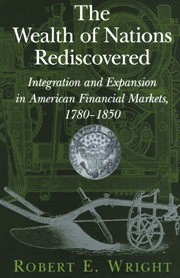 The Wealth of Nations Rediscovered
The Wealth of Nations Rediscovered Book contents
- Frontmatter
- Contents
- List of Tables
- Acknowledgments
- List of Abbreviations
- The Wealth of Nations Rediscovered
- 1 Introduction: The Wealth of Nations and National Wealth
- 2 The International and Colonial Background of America's Financial Revolution
- 3 Banks, Securities Markets, and the Reduction of Asymmetric Information
- 4 The Financial Sector and the Reduction of Lending-Related Costs and Risks
- 5 Evidence of Capital Market Integration, 1800–1850
- 6 Expansion of the Securities Services Sector, 1790–1850
- 7 The Freest of the Free: Regulation of the Financial Sector
- 8 Finance-Directed Economic Development
- 9 Conclusion
- References
- Index
6 - Expansion of the Securities Services Sector, 1790–1850
Published online by Cambridge University Press: 16 January 2010
- Frontmatter
- Contents
- List of Tables
- Acknowledgments
- List of Abbreviations
- The Wealth of Nations Rediscovered
- 1 Introduction: The Wealth of Nations and National Wealth
- 2 The International and Colonial Background of America's Financial Revolution
- 3 Banks, Securities Markets, and the Reduction of Asymmetric Information
- 4 The Financial Sector and the Reduction of Lending-Related Costs and Risks
- 5 Evidence of Capital Market Integration, 1800–1850
- 6 Expansion of the Securities Services Sector, 1790–1850
- 7 The Freest of the Free: Regulation of the Financial Sector
- 8 Finance-Directed Economic Development
- 9 Conclusion
- References
- Index
Summary
In the previous chapter, we learned that the early U.S. securities sector was modern in the sense that it was price-integrated and transactionally efficient. But was it large enough to matter? Scholars know precious little about the trading patterns of America's early “stock” – corporate equities and government debt, such as U.S. Sixes. There are several reasons why, until just a few years ago, the early U.S. securities sector received very little scholarly attention. First, intensive archival research was necessary to show that the early securities markets were broader (more issues) and deeper (more trades) than hitherto believed. Those trained in archival research, primarily historians, were little interested in the actual functioning of the economy, preferring instead to explore the public policy debates, most of which concerned banks and banking. Those interested in the functioning of the economy, mostly economists, did not have the archival temperament necessary to find relevant sources, which were often deeply buried in disintegrating newspapers, crusty account books, and giant, filthy bank ledgers. The topic, in other words, fell into the crevice between two disciplines. Second, and just as important, until recently there was little theoretical reason to jump into that Great Divide to see what could be found. Finance was thought to follow, rather than to lead, economic growth. Many now argue otherwise, so there is incentive to explore the early securities sector in detail.
This chapter first addresses the brokerage industry, describing the functions, commission rates, and numbers of brokers.
- Type
- Chapter
- Information
- The Wealth of Nations RediscoveredIntegration and Expansion in American Financial Markets, 1780–1850, pp. 123 - 166Publisher: Cambridge University PressPrint publication year: 2002


